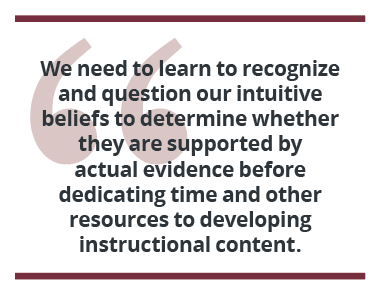By Xin Sun
We need to learn to recognize, question, and verify the underlying beliefs that influence how we develop instructional and technical content. Basing content-related decisions on scientific evidence, rather than myths, allows us to focus on what really matters.
The myth of learning styles has become pervasively influential in numerous fields concerning learning and instruction. Despite its popularity, the concept of learning styles has never been supported by scientific evidence. Creating content based on the myth of learning styles can have serious and negative consequences in all fields of communication, including educational sciences, instructional design, and technical communication.
What Are Learning Styles?
The idea of “learning styles” proposes that every individual learns in a different way, and that instructional content is most effective when it matches an individual’s specific mode (or style) of learning.
While there are many learning style models, they all involve two basic propositions:
- The way people learn can be classified into different “styles” based on individual preference. This preference is often correlated with a specific sensory mode. For example, one of the most popular learning style models is the VAK model, which suggests three learning styles: visual, auditory, and kinesthetic styles.1
- Individuals achieve better learning outcomes when the instructional content matches their learning styles. For example, visual learners learn best through seeing graphical items, auditory learners learn best through listening (e.g, lectures), and kinesthetic learners learn best through physical action.
What the Evidence Tells Us
The idea of learning styles is appealing, and it is not entirely wrong. It is correct that individuals learn in different ways and have different learning outcomes, even when interacting with the same instructional content. Some people learn faster than others. And many people do have a strong personal preference for certain types of instructional content.
 Although intuitively appealing, the notion of learning styles lacks sound, evidence-based research to back up its major claims. Unfortunately, there are many peer-reviewed publications that claim to have found cause-and-effect relationships between learner preference, content type, and learning outcomes.2 However, while many of these studies do verify a strong personal preference for a certain type of instructional content, they do not validate the cause-and-effect relationship. In many of these studies, the methodology, reasoning, or both, are deeply flawed.
Although intuitively appealing, the notion of learning styles lacks sound, evidence-based research to back up its major claims. Unfortunately, there are many peer-reviewed publications that claim to have found cause-and-effect relationships between learner preference, content type, and learning outcomes.2 However, while many of these studies do verify a strong personal preference for a certain type of instructional content, they do not validate the cause-and-effect relationship. In many of these studies, the methodology, reasoning, or both, are deeply flawed.
In one well-designed study,3 researchers used several validated questionnaires to identify students’ learning styles as either “visual” or “verbal.” Students were then randomly assigned a learning session with either picture-based or word-based content. While the questionnaires efficiently separated the visual learners from verbal learners, the groups did not differ in their learning outcomes. In other words, learning styles did not matter — when engaging with the picture-based content, those with a strong preference for visual content did not learn better than those with a strong preference for word-based content.
While learning styles have not been scientifically validated, researchers have found several other legitimate reasons for differences in learning success,2 and these include, but are not limited to:
- Talent or aptitude
- A high degree of motivation
- Relevant prior knowledge
Indeed, learning outcomes vary for many reasons; however, learning styles is not one of them. As summarized in a 2008 literature review of learning styles, “Although the literature on learning styles is enormous, very few studies have even used an experimental methodology capable of testing the validity of learning styles applied to education.”2
Perhaps most importantly, these well-designed studies often support the use of multimedia learning environments. Research shows that presenting materials in various ways, rather than through a single modality, results in optimal learning.2
The Detrimental Effects of the Learning Style Myth
The prevalence of the learning style myth has several negative consequences. It shifts attention away from the factors that may really matter to learning. Students (and their guardians) may focus on finding and engaging with content that matches with their ostensible learning styles, rather than on more effective learning techniques.
The myth perpetuates the belief that instructional materials should be designed to fit the needs of different learners. Thus, people who develop instructional content are likely to invest time and effort in creating various types of content that do not actually benefit students at all. While instructors spend time and other resources on assessing student learning styles, and on creating and assigning different content types to different students, they are neglecting important cognitive and motivational factors that have a real effect on learning outcomes.
As educational psychologist Dr. Daniel Willingham puts it, we should focus on the individual differences that really matter:
We shouldn’t congratulate ourselves for showing a video to engage the visual learners or offering podcasts to the auditory learners. Rather, we should realize that the value of the video or audio will be determined by how it suits the content that we are asking students to learn and the background knowledge, interests, and abilities that they bring to it.4
The learning style myth is also detrimental on a broader scale. It is already embedded in many teacher training programs as one of the guiding principles of pedagogy. Moreover, in 29 U.S. states, this myth is included in government-distributed exam preparation materials.5 This widespread doctrine passes on misguided beliefs and behaviors and will continue to result in wasted efforts for future generations of both instructors and students.
Looking Ahead: Toward an Evidence-Based Approach
Clearly, it is important to refrain from approaching instruction and communication with a learning-style mindset. In a larger sense, it is also important to learn how to avoid the pitfalls of similar myths in the future. It is critical to learn how to use sound reasoning and approach all content decisions in an evidence-based way. We need to learn to recognize and question our intuitive beliefs to determine whether they are supported by actual evidence before dedicating time and other resources to developing instructional content. We also need to learn how to assess the credibility of various claims and sources — even peer-reviewed publications.
Our research found that more than 90 percent of the people we surveyed believed in the myth of learning styles.6 When asked why, most participants referred to deeply personal experiences, and responded with statements such as, “My kid has a learning style.” Such individual personal experiences are not a sound basis for an
evidence-based approach.
The good news is our study included teaching participants about the science behind the learning style myth, and more than half of our participants altered their beliefs. When asked to explain this shift, most of them mentioned, “Studies showed…” This indicates that people can be educated and persuaded to abandon misleading myths in favor of an evidence-based approach that allows us to focus on what truly matters for improving learning outcomes.

XIN SUN (sunxin@umich.edu) is a PhD candidate in the Combined Program in Education and Psychology at the University of Michigan Ann Arbor. She studies individual and cultural differences in people’s beliefs about learning. She has published in many peer-reviewed journals, including the Journal of Experimental Psychology: General, npj Science of Learning, and Child Development. Her Twitter handle is @xinsun1007.
References
- Franklin, Shirley. 2006. “VAKing out Learning Styles—Why the Notion of ‘Learning Styles’ Is Unhelpful to Teachers.” Education 3-13, 34 (1): 81–87. https://doi.org/10.1080/03004270500507644.
- Pashler, Harold, Mark Mcdaniel, Doug Rohrer, and Robert Bjork. 2008. “Learning Styles: Concepts and Evidence.” Psychological Science in the Public Interest, 9 (December): 105–19. https://doi.org/10.1111/j.1539-6053.2009.01038.x.
- Massa, L. J., & Mayer, R. E. 2006. Testing the ATI hypothesis: Should Multimedia Instruction Accommodate Verbalizer-Visualizer Cognitive Style?”. Learning and Individual Differences, 16 (4), 321–335. https://doi.org/10.1016/j.lindif.2006.10.001
- Riener, C., & Willingham, D. 2010. “The Myth of Learning Styles.” Change: The Magazine of Higher Learning, 42 (5): 32-35. https://doi.org/10.1080/00091383.2010.503139
- Furey, William. 2020. “The Stubborn Myth of ‘Learning Styles.’” Education Next, 20 (3). https://www.educationnext.org/stubborn-myth-learning-styles-state-teacher
-license-prep-materials-debunked-theory/ - Nancekivell, S., Sun, X., Gelman, S., & Shah, P. (Accept pending revision under Cognitive Science). “A Slippery Myth: How Learning style Beliefs Shape Reasoning About Multimodal Instruction and Related Scientific Evidence.”


